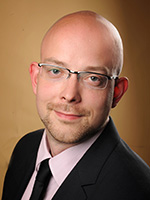Welcome Dr Sascha Duczek
Dr Sascha Duczek has recently arrived in Sydney from Otto von Guericke University in Magdeburg, Germany. He is, however, no stranger to Australia, having completed some of his postgraduate studies in Adelaide. As a CVEN Lecturer and a member of the Centre for Infrastructure and Engineering Safety (CIES), Sascha will be developing his research in Computational Mechanics, especially in high order Finite Elements Methods (FEM).

Dr Duczek’s enthusiasm for computational mechanics began early in his career and he has continued to refine his approach. “Computational mechanics (CM) is a broad range of different methods, commonly based in numerical approaches, and used to solve partial differential equations. All physical problems present a certain set of partial differential equations (PDEs) to which we have to apply numerical (approximative) methods. I concentrate on Finite Element Methods in the context of high order shape functions. Commercially, FEMs often utilize linear or quadratic shape functions, but I try to exploit the inherent advantages of high order ones.”
Commercially, FEMs often utilize linear or quadratic shape functions, but I try to exploit the inherent advantages of high order ones.
Dr Sascha Duczek
Duczek’s first big project was in aviation safety. “We developed a system similar to the human nervous system where we placed transducers (sensors/actuators) at selected points throughout a physical structure, then sent waves through that structure, measuring them at various points to reveal damage or weakness. In this context, the central processing unit (CPU) takes the role of the human brain and processes the measured signals. Computational mechanics then steps in to compute the wave propagation efficiently and precisely. These validated computations then have an incredibly broad range of applications in the field, in real life situations such as earthquakes and in a variety of large structures.”
Computational mechanics, then, is essentially part of an inter-disciplinary approach to engineering. Reliable numerical methods have to be validated by experiments. This ensures the high-fidelity prediction of physical phenomena in the analysis of innovative designs. The seeds of CM were planted in the 1950s, but it was only with the rapid development of computer technology that it began to become established as a discrete discipline. Today its rapidly evolving nature is demanding the development of ‘high performance computing’ with ‘brains’ big enough to handle this high order evolution.
Duczek will be well supported at CVEN. Professor Chongmin Song, Director at CIES and an expert in Scaled Boundary FEM, shares his enthusiasm for computational mechanics. Duczek will convene CVEN4308 Structural Dynamics, utilising his expertise in dynamic analysis, transient dynamic analysis and nonlinear dynamic analysis. He will also be co-teaching CVEN3304 Concrete Structures with colleague Dr Taewhan Kim, an engineer with a materials-based research profile. Sascha’s teaching style is to encourage students to actively seek answers, requiring self-motivation, effort and commitment: “I am not here to provide all the information required, but to stimulate enquiry.”
Duczek’s presence at CVEN will expand the existing areas of expertise, while shared interests will facilitate collaboration. He is keen to maintain his research connections with his German colleagues. Simultaneously, Duczek is developing proposals for the German Research Foundation and the Australian Research Council. Both of these projects will constitute developments on previous research. Generally, these projects will investigate modelling the behaviours of complex acoustic materials like dampening foams. These materials exhibit both open and closed cell structures that make modelling a complex challenge, necessitating high performance computing technology. “We will look at the relationship of these complex materials to the environments in which they are used. In urban areas, uses such as engine encapsulation can reduce noise pollution. Engine heat can be retained to increase start up efficiency, reducing emissions and fuel consumption. These materials could have positive effects on urban well-being.”
Duczek would also like to build more understanding between the engineering academy and the engineering industry. “Certain commercial computational methods are based in knowledge from the 1980s and 1990s, while the newer computational research has the potential to greatly increase industrial efficiency. Sometimes industry can be a little conservative, reluctant to invest either time or money to adopt new methods.” He sees the distinction between academic researchers and industry as being neatly articulated by the Pareto Principle. “80% of the work is completed in 20% of the time. To get to that final 20% of the work, a big time and resource investment is needed, but it is here that innovation, academic rigor and excitement lie.” His desire is to see this distinction diminished through increased understanding between the sectors.
And Duczek knows he is in the right place. The School of Civil & Environmental Engineering is renowned for its strong industry relationships, and if deepened understanding is possible anywhere, it is possible here. He is also enjoying the ‘united nations’ demographics of his new place in the world. So many academics from so many varied places across the globe present interesting opportunities both “academically and socially”. He is enjoying the supportive and flexible working conditions, offering him a positive career trajectory in what he knows is an internationally highly ranked engineering school. He is very happy to be here.



